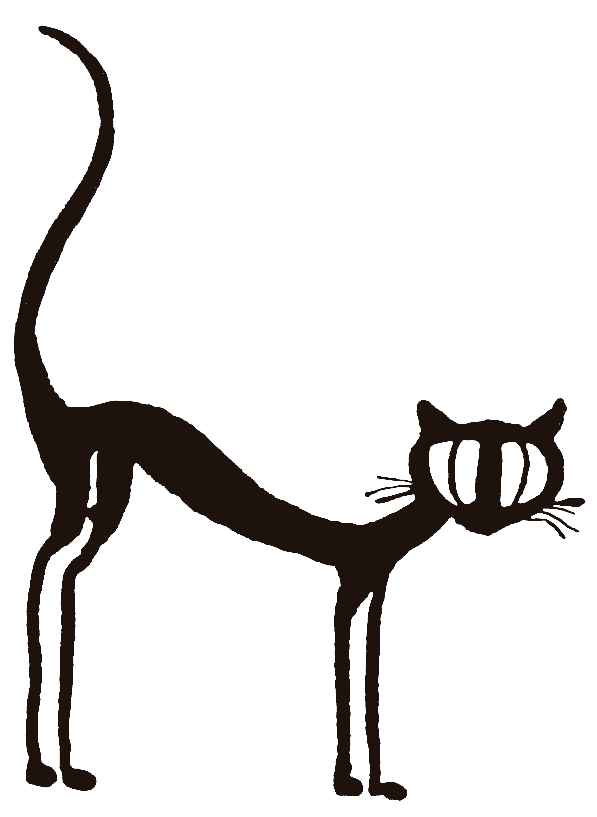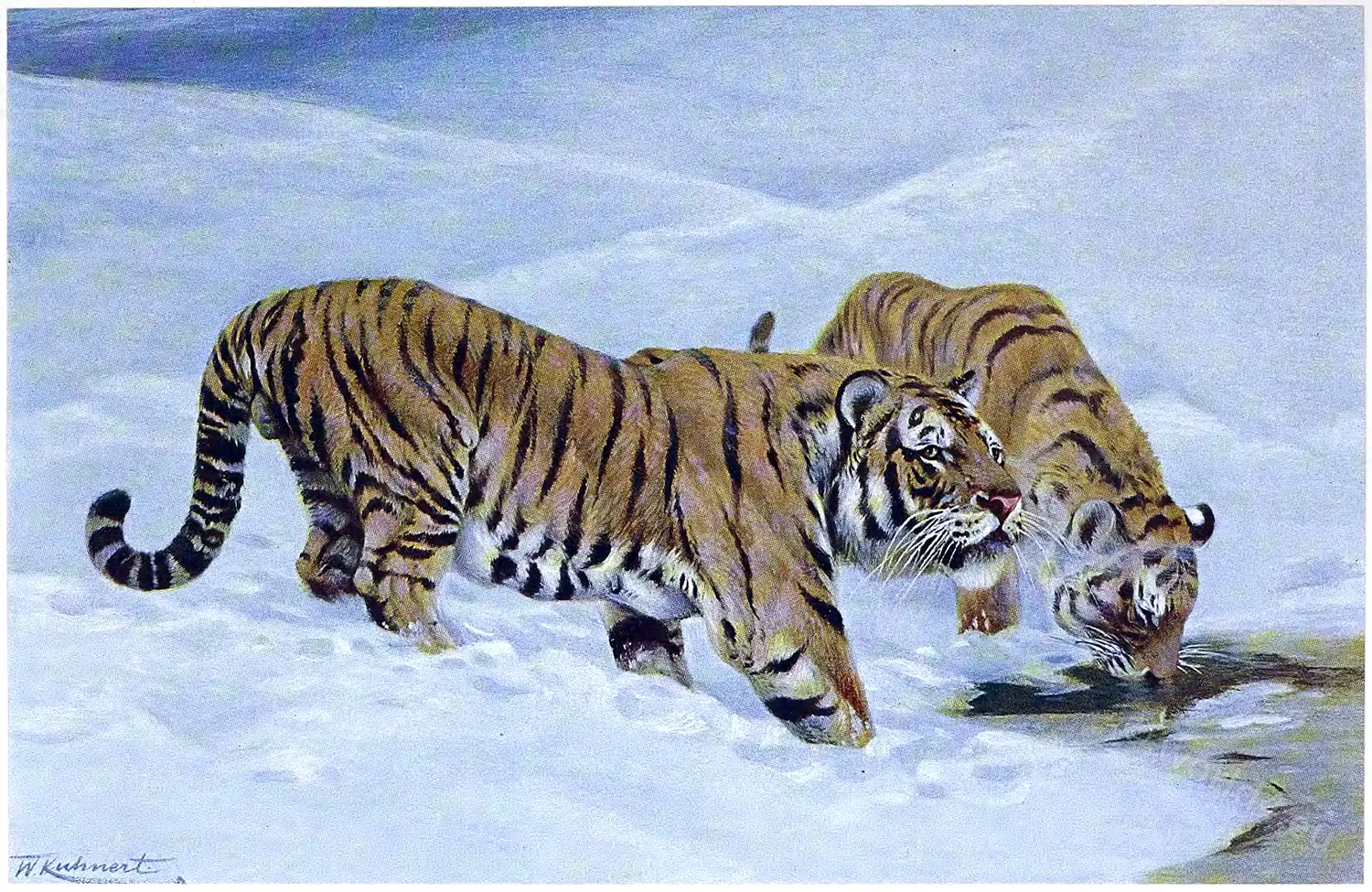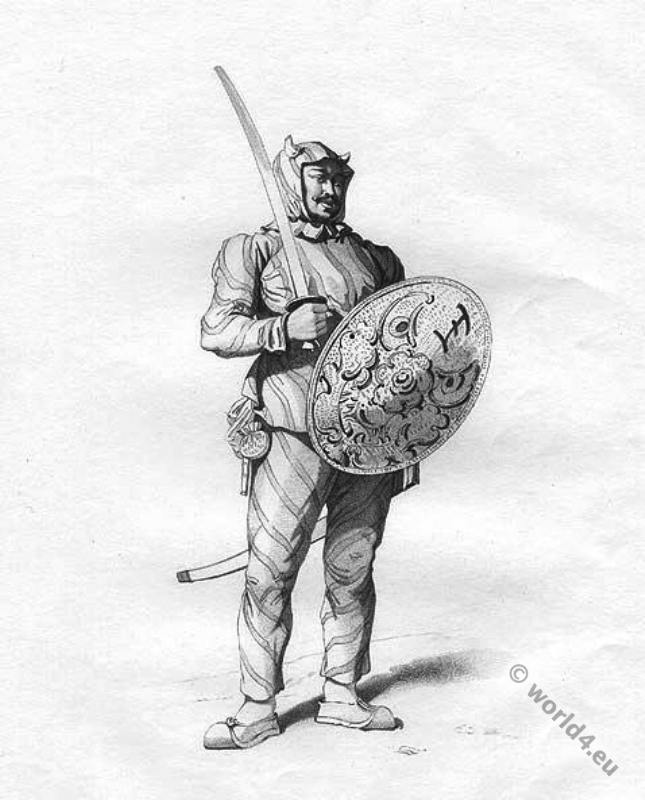THE MANCHURIAN TIGER (Felis tigris mongolica)
THE tiger is, and apparently always has been, an essentially Asiatic animal, although it enters south-eastern Europe in the Caucasus, whence its range extends eastwards through Persia, Afghanistan, and India, to Java and Sumatra, while northward it is found through China and Mongolia to Korea and Amurland. Very noteworthy is its absence from Ceylon, which seems to indicate that its original home was central Asia, and that it is a comparatively recent immigrant into southern Asia.
Four local races of the tiger are recognised by naturalists, namely, the typical Indian tiger, the Persian tiger [F. tigris uirgata), the Javan tiger (F. t. sondaica), and the Manchurian or Siberian tiger (F. t. mongolica or longipilis). As regards splendour of coat, the finest of these races is the Manchurian tiger, which differs from the Indian race by the great length and woolliness of its winter coat and the larger extent of white on the face, under-parts, and the inner side of the limbs.
It also appears to be a more stoutly built animal, and attains a very large size. Its skin commands a very high price. From both these races the Persian tiger, which is probably the one found in the Caucasus, differs by the copious fringe of long hair on the cheeks, throat, and under-parts; while it is also of inferior bodily size.
The Javan and Sumatran tiger, which may be the same as the one inhabiting the Malay countries, differs from all the other three by the light areas on the head, body and limbs being of small extent, ill-defined, and dirty or buffish white in colour instead of pure white. In size it is always relatively small, and appears to be the smallest of all. The degree of development of the dark stripes appears to vary individually but the Persian race seems to be the most fully striped of all, and shows in perfection the characteristic looping, or splitting of the stripes.
The striped coat of the tiger seems designed to break up the outline of the body, and thus to render the animal as inconspicuous as possible. That it is not, as was once thought, a special adaptation to match the surroundings of the animal in the jungles of Bengal, will be evident from what is stated above as to the distribution of the tiger and its comparatively recent entry into India.
Information is still required with regard to the habits of the Manchurian tiger, which has only of recent years been hunted by European sportsmen, or exhibited alive in zoological gardens. It appears, however, that these northern tigers prey on almost all the animals of their native country, from the largest to the smallest. In summer they will overpower and kill such fierce animals as bears, while in times of scarcity during the long winter they may be driven to prey on mice and rats.
To capture their victims they frequently resort to the drinking-places of the latter, and in summer they likewise pay constant visits to the salt-pans where the wapiti and other deer come to lick the salt.
Each pair of tigers generally frequents the same lair, which in mountainous districts is concealed amid rocks, while in the plains the requisite shelter is afforded by reed-brakes. In winter the tigers may be completely snowed up in their retreats. As in India, the tigress is reported to separate herself from the tiger a short time before giving birth to her young; these being born in some dense thicket or rocky cleft, their number varying from two to four.
At birth they are about the same size as lion-cubs, but are marked in the same fashion as their parents, although clothed in more woolly coats. In India it is generally stated that the female keeps apart from the male while the cubs are young, although both parents have been seen with their offspring. Like lions, tigers associate for the greater part of the year in pairs, and are strictly monogamous.
Whether old tigers in Siberia turn man-eaters, after the fashion of their brethren in India, does not appear to be known; but in much of their range it is probable that they do not resort to this mode of livelihood, on account of the sparseness of the population. It appears, however, that throughout northern China and Siberia the natives regard the tiger with much the same superstitious awe as do the natives of Hindustan. All the Siberian natives consider the tiger as a being of high nature, although the Tunguses look upon it as an evil spirit which has come under the influence of the Shamans, or sorcerers.
Fossil bones from the New Siberian Islands indicate that the Manchurian tiger once ranged beyond the Arctic Circle.
Source: Animal portraiture by Richard Lydekker (1849-1915); Wilhelm Kuhnert (1865-1926). London: Frederick Warne & Co. 1912.

Discover more from World4 Costume Culture History
Subscribe to get the latest posts sent to your email.



